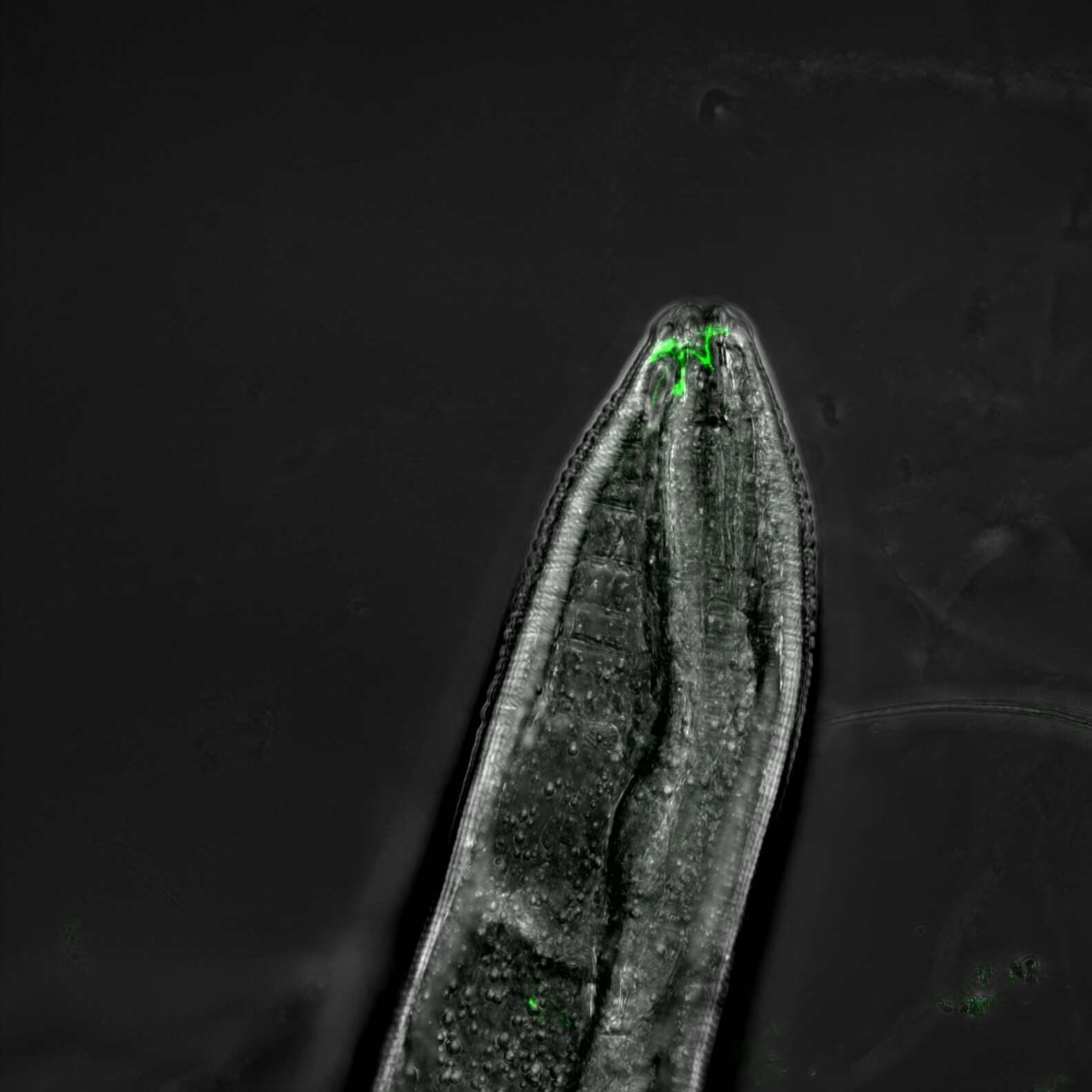Main Second Level Navigation
Donnelly Centre Researchers Crack 30 Year Old Mystery of Odor Switching in Worms

To smell or not to smell can be a matter of life and death, especially for soil-dwelling nematodes that chiefly rely on olfaction for survival. But how these worms discriminate between more than a thousand different scents has puzzled scientists for decades.
Now, Donnelly Centre researchers have uncovered a molecular mechanism behind this process and show that it involves a conserved protein that helps equilibrate vision in humans. The implications of their finding stretch beyond nematode olfaction and could also help explain how our brains work.
The research was led by Derek van der Kooy, a professor of molecular genetics in the Donnelly Centre for Cellular and Biomolecular Research, at the Temerty Faculty of Medicine. The van der Kooy lab is renowned for its neuroscience research that uses a variety of model organisms, including the nematode Caenorhabditis elegans.
The journal Proceedings of the National Academy of Science in the USA published their work.
“The worms have an incredible sense of smell — it’s absolutely amazing,” says Daniel Merritt, a first co-author on the paper and a newly minted PhD graduate from the van der Kooy lab following his thesis defense last week.
“They can detect a very wide variety of compounds, such as molecules released from soil, fruit, flowers, bacteria. They can even smell explosives and cancer biomarkers in the urine of patients,” he said.
C. elegans are champion sniffers thanks to possessing around 1300 odorant receptors, whose discovery began three decades ago. Like in humans, who have about 400 receptors, each receptor is dedicated to sensing one type of smell, but this is where similarities end.
Our noses are lined with hundreds of sensory neurons, each expressing only one receptor type. When an odorant activates a given neuron, the signal travels deeper into the brain along its long process, or axon, where it is perceived as smell. Smell discrimination is enabled by a physical separation of axonal cables carrying different smell signals.
The worms, however, have only 32 olfactory neurons, which hold all of their 1300 receptors.
“Clearly, the one neuron-one smell strategy is not going to work here,” Merritt said.
Yet, the worms can discriminate between different smells sensed by the same neuron. Pioneering research from the early 1990s showed that when exposed to two attractive odors, where one is uniformly present and the other is localized, the worms crawl towards the latter. But how this behaviour is regulated at the molecular level remained unclear.
“It seems that all the information that is sensed by this neuron gets compressed into one signal, and yet the worm can somehow tell the difference between the upstream components. That’s where we came to it,” said Merritt.
Merritt and former master’s student Isabel MacKay-Clackett, also a co-first author on the paper, reasoned that perhaps the worms are sensing how strong the smells are.
According to their hypothesis, the smells that are everywhere are not the most informative cues and would become desensitized in some way, meaning the worms would ignore them. This would leave the weakly present smells, which might be more useful in guiding behaviour, able to activate their receptors and cause signal transduction.
They also had a hunch for how this could work at the molecular level. A protein named arrestin is a well-established desensitizer of the so called- G protein coupled receptors (GPCRs), a large family of proteins that perceive external stimuli, which odorant receptors belong to. Arrestins for example allow us to adjust vision in bright light by damping down signalling through the photon-sensing receptors in the retina.
The team wondered if arrestin might also act in worms to desensitize receptors for a stronger smell in favour of those for a weaker one, when both are sensed by the same neuron. To test their hypothesis, they exposed the worms lacking the arrestin gene to two different attractive smells in a Petri dish. They mixed one smell into the agar medium to make it uniform, and put the worms on top. The other smell was placed at one spot some distance from the worms.
Time-lapse video of C. elegans worms on an agar plate locating a drop of an attractive odor (blue circle). 180X actual speed. Credit: Daniel Merritt
Without arrestin, the worms were no longer able find the source of the weaker smell. Like in the human eye squinting in bright sunshine, arrestin helps remove an overpowering sensation—ambient smell in this case—so that the worms can sense a localized smell and move towards it, MacKay-Clackett said.
Arrestin is not required, however, when the smells are sensed with different neurons, suggesting that the worms employ the same discrimination strategy as the vertebrates when the smell signals travel down different axons.
The team looked at different sets of smells and neurons and found they all obeyed the same logic, said Merritt. They also used drugs to block arrestin and found that this too abolished smell discrimination.
The finding is significant because it is the first evidence showing that arrestin can fine tune multiple sensations.
“There is no case known in biology before this where arrestin is being used to allow for discrimination of signals external to the cell,” said Merritt.
He added that the same mechanism could be playing out in other animals when multiple GPCRs are expressed on the same cell, especially in the brain. Our brains are bathed in neurochemicals that signal through hundreds of different GPCRs, raising a possibility that arrestin, of which there are four types in humans, could be key for information processing.
“Our work provides one piece of puzzle how the worms’ amazing sense of smell works, but it also informs our understanding of how GPCR signalling works more broadly within animals,” said Merritt.
This research was supported by funding from The Canadian Institutes of Health Research and The Natural Sciences and Engineering Research Council of Canada.
Follow us on LinkedIn and Twitter to keep up with Donnelly Centre news.
News



